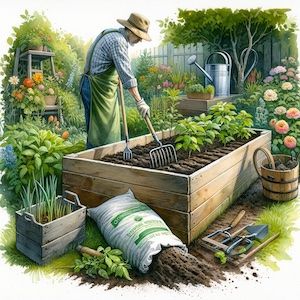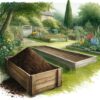Is it time to refresh your raised bed?
Welcome to our garden blog! Today, we delve into an essential aspect of raised bed gardening – refreshing the soil. This practice is key to maintaining a vibrant and productive garden. Whether you’re a green thumb enthusiast or a newcomer to gardening, understanding why, when, and how to refresh your raised bed soil is crucial for ensuring your garden’s success. Let’s explore the importance of this process and provide a step-by-step guide to help you along the way.
Why Refresh Raised Bed Soil?
Refreshing the soil in your raised beds is more than just routine maintenance; it’s a critical step for ensuring the health and productivity of your garden. Soil can become compacted and nutrient-depleted over time, leading to less vigorous plant growth. By rejuvenating your soil, you’re directly impacting the health of your plants, leading to a healthier garden and a more fruitful harvest. Refreshing your soil also helps prevent the accumulation of soil-borne diseases and pests, safeguarding your garden’s wellbeing.
When to Refresh Your Raised Bed Soil
Timing is key in refreshing your raised bed soil. The ideal times are annually, in early spring before planting begins, or in the fall after harvesting. However, certain signs may indicate the need for more frequent refreshment. These include noticeable declines in plant health, disappointing yields, and results from soil tests, which should be conducted every 2-3 years.
Step-by-Step Guide to Refreshing Your Soil
1. Clear and Clean
Start by removing old plants, roots, and weeds from your raised bed. This step is essential for preventing disease and pest transfer.
2. Loosen and Aerate
Gently till the soil to a depth of about 6-12 inches. This improves the soil structure and prepares it for new amendments.
3. Enrich with Organic Matter
Add a layer of compost, aged manure, or other organic materials. This is vital for replenishing nutrients in the soil.
4. Balance with Amendments
If your soil test shows deficiencies or pH imbalances (you can use our simple pH and soil meter), add necessary amendments like bone meal, green sand, or lime.
5. Top Up with Fresh Soil
Add new topsoil mixed with compost if the soil level has decreased significantly. This not only replenishes the soil volume but also introduces new nutrients.
6. Mulch After Planting
After planting, apply a layer of mulch to help retain moisture, regulate soil temperature, and prevent weed growth.
By following these steps, you can effectively refresh the soil in your raised beds, ensuring a foundation for a thriving garden. Whether you aim to grow lush flowers or abundant vegetables, maintaining your raised bed soil is a key element of gardening success. Remember, a little effort in soil care can lead to impressive rewards in plant health and productivity. Happy gardening! Want more raised bed info? See our raised bed gardening FAQ.










